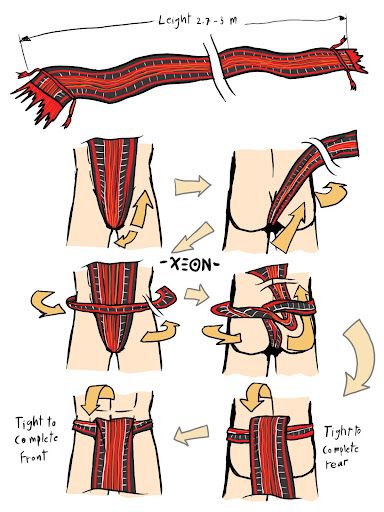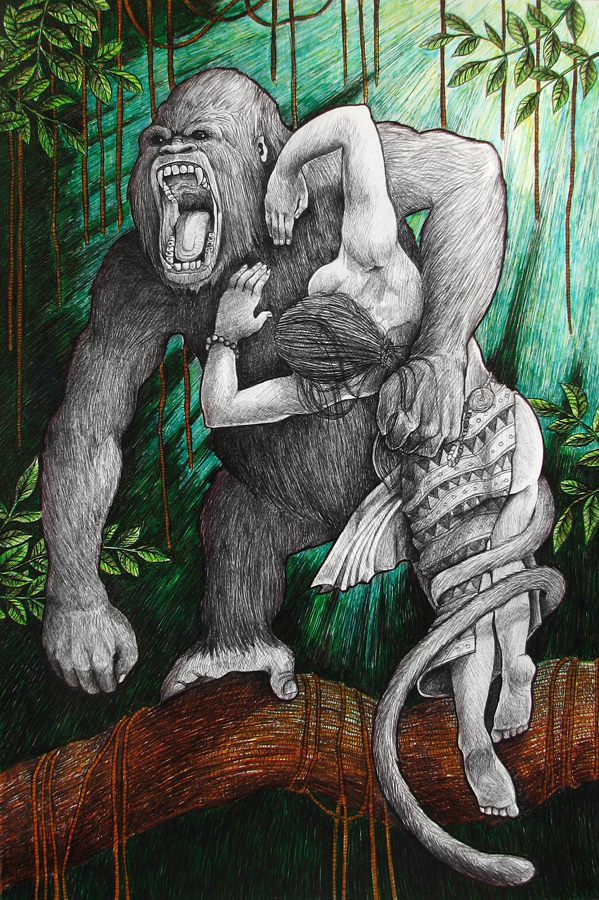The fateful meeting of “civilized” and primitive factions in the world during the Age of Discovery forced an escalation of the Western ideals of progression. Among the lands that were “discovered” during this grand period was the Philippines. Of course, history tells us that conquistadors embarked on their journey to the east for spices and to spread the word of God – while also trying to gain more riches, power, land and colonies. They wrote pages and pages of their chronicles; narrating as they set foot on new lands in hopes of pleasing their monarchy and leaving a lasting legacy in this world.

Among a few, the thirst for knowledge would eventually lead some journeymen from the west to strange and unfamiliar sights that would challenge both their imagination and rational minds. For within the 7,107 cluster of islands known as the Philippines, they would find peculiar men that blend beauty and monstrosity alike.
Monsters in Disguise
Although there are many historical stories that feature people possessing unnatural physique, the tale of the Philippine’s tailed men only surfaced in 1696 when a Jesuit missionary narrated it to an Italian visitor named Giovanni Careri. On the island of Mindoro, a tribe of Manghians (Mangyans) are known to have “ a tail half span long (11.5cm)”. In 1738, reports coming from a Franciscan missionary, under the name of Juan Francisco de San Antonio, affirmed the Jesuit’s story stating that among a certain tribe in Mindoro, there is a man (and this claim was allegedly supported and proven true by “many” friars) who has a tail like a monkey.

Those testimonies heighten the interest of Jean Mallat (Author: The Philippines, 1846) and even our own Isabelo delos Reyes (politician, writer and labor activist). However, both scholars debunked the said accounts. Even still, stories circulated about Mangyan women having relations with monkey – not unlike similar rumours about some tribal women in Borneo having relations with Orangutans (the name orangutan means “man of the forest“). Explaining genetic differences by assuming relations with something other than humans is not an unusual phenomena. I could recounts tales from the Philippines where albino children are through to have been sired by an “engkanto”. This simply causes more intrigue for these incredible, yet unexplained, tales.
Scientific Perspective
During the early age of science, studies involving monstrous physiques of animals and plants, known as Teratology, paved way for a sensational interest – which opened a lot of theories involving the connection of man to animals (specifically with simian species like monkeys). Charles Darwin’s debatable theory of men evolving from apes created a lot of noise back then, and even today, among the scientific community.
Many travellers and authors such as Marco Polo and Ptolemy offer their own experiences with peculiar races of men. Some of these were supposedly found in undiscovered areas of Africa, Turkestan, India, China and the Philippines. The unusual features, such as wings, tails, colossal heights and hairy bodies, might be abominable at first sight but were believed to have a deep connection with the gods and supernatural phenomenon in the form of destructive typhoons, volcanic eruptions and earthquakes. This led others to see these strange featured men as bringers of apocalyptic events or as some kind of divine messenger.
These accounts may be sounding fictional and terribly lacking of verity, but scholars continue to dig deeper, making the study of “monsters’’ have a serious and somewhat stimulating tone. At the end of the seventeenth century, science associated the traits of these monsters with natural and medical causes. Thus, having these traits were considered to be an anatomical abnormality which may have developed during the embryonic stage and not because of any supernatural cause. Until today, this kind of explanation is widely accepted both by scientists and the general public.

However, before Darwin, a Cambridge physician namely Edward Tyson compared the traits of men and apes in his study “Orang-Outang, sive Homo Sylvestris: or the Anatomy of a Pygmie Compared with that of a Monkey, an Ape, and a Man (1699)” where he pointed out how the pygmy is more like a man than an ape, and how the pygmy is more like an ape than a man. For this study, he became known as the father of comparative anatomy.
The study of monsters and the connection of ape and men eventually started to decline at the beginning of twentieth century, but that doesn’t mean that its impact has died down.
For the tailed men of the Philippines, it turned out that it was not a medical malformation, as much as it was a gross assumption and misunderstood perception of an “inferior” race and their traditional attire.

Who is the real Monster?
An anthropologist by the name of Edward Tylor quoted that the beliefs of tailed men is somewhat linked with the “despised tribe of aborigines, outcast or heretics near or among a dominant population” wherein they are always looked upon as “beast with tails”. He cites examples of these races or tribes that fell prey to the judging eyes of others ranging from the Miau-tze of China, Niam-Niam of the Moslem nations of Africa, the Cagots race of Pyrenees and lastly the Jews – who, in Spain, were superstitiously believed to have a tails like the devil himself.
The stories of the tailed men in the Philippines on the other hand went viral during the America period. Fictional tales from Ivan Gruners Cook about the Ikugan, or tailed men of the Manobos, was published in Manila’s American Chamber of Commerce Journal (1929) and in an article from the San Francisco Examiner entitled “The Man With a Tail, An Igorot of Luzon” (1930). These ignorant views spurred hatred among Filipinos towards some of the Americans who propagated these stories. It did however fuel support for the campaign to have the U.S congress grant independence to the Philippines.
“Flagrant and entirely libellous”, said a Cebuano writer in an article from the “Bag-ong Kusog” (Cebu City, August 2, 1929) who vehemently defended the Filipinos against the rumors propagated by rude American soldiers. He stated that the white men didn’t process entirely the fact that the supposed tails of tailed men might results from of rare medical malformations such caudal lipomas and teratomas. It was further stated that those foreigners were ignorant about the clothing of certain tribal men such as the Igorots – where their breech-clouts (Bahag) have a “tail” in the design of the waist clothes and leather appendages worn behind their girdle.
The article may have shed light on the stories of tailed men back in the early 20th century, but the stained depictions of tailed men as inferior, bestial and even entirely “hellish” proves much harder to erase.
Misunderstood Culture leads to Ignorance and Misconception
Monsters or creatures endowed with bestial appearances are inherently found in various folklore and myths. These concepts were difficult for Westerners to grasp as they set out to conquer new lands. The derogatory stories of tailed men may certainly have been created by foreign minds, but certain lore in the Philippines have also recorded stories about men with tails, long before the coming of Spaniards and Americans.
Anthropologist John Garvan gave us an account of the Manobo’s story of the tailed men they called Tidung, who invaded the Agusan Valley. Notable in the Tidung story is that the male Tidung have tails in the shape of a dagger, while female’s tail is like an adze (an axe like tool). Garvan pondered in his study, “It would be interesting to know whether these Tíduñg were members of a tribe in Borneo that made piratical raids to the Súlu Archipelago”. The Bisayans and Bicolanos added more flare and imagination to the raiders from Borneo which they described as tailed ogres and cannibals or strong dwarfish entities dwelling in cliffs and caves.
On the other hand, the Batangenyo stories of Tirong are neither monstrous nor merciless pirates, but a prestige class of blade wielding, bull riding, ancient warriors. They are depicted in a black cloak which emanates a grim impression to many that they readily embrace death as just one step ahead – knowing that their lives are embroiled in fighting their enemies and protecting the weak.
And who hasn’t heard of the the mythical being called the Ikugan? This creature is portrayed as a huge simian with a long tail, lurking in the jungle of Philippines. It likely stems from Garvan’s study in which this particular chapter was called “THE STORY OF THE IKÚGAN, OR TAILED MEN, AND OF THE RESETTLEMENT OF THE AGÚSAN VALLEY”

In the end, we are left with a real mix of fact, fiction, ignorance, imagination, and confusion. If only if the men from “civil lands” learned to first appreciate the beauty of our culture and lore before taking a superior stance against our ancestor’s “inferior” appearance and customs.
Imagine hearing American soldiers singing a song with hurtful lyrics such as “the monkeys have no tails in Zamboanga”.
(Source: Isabelo’s Archives by Resil Mojares, Originally Published on 2013)
ALSO READ: Devils in the Philippines: From Demonization to Abandonment
Currently collecting books (fiction and non-fiction) involving Philippine mythology and folklore. His favorite lower mythological creature is the Bakunawa because he too is curious what the moon or sun taste like.


